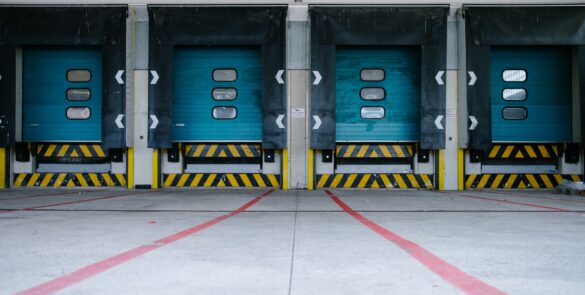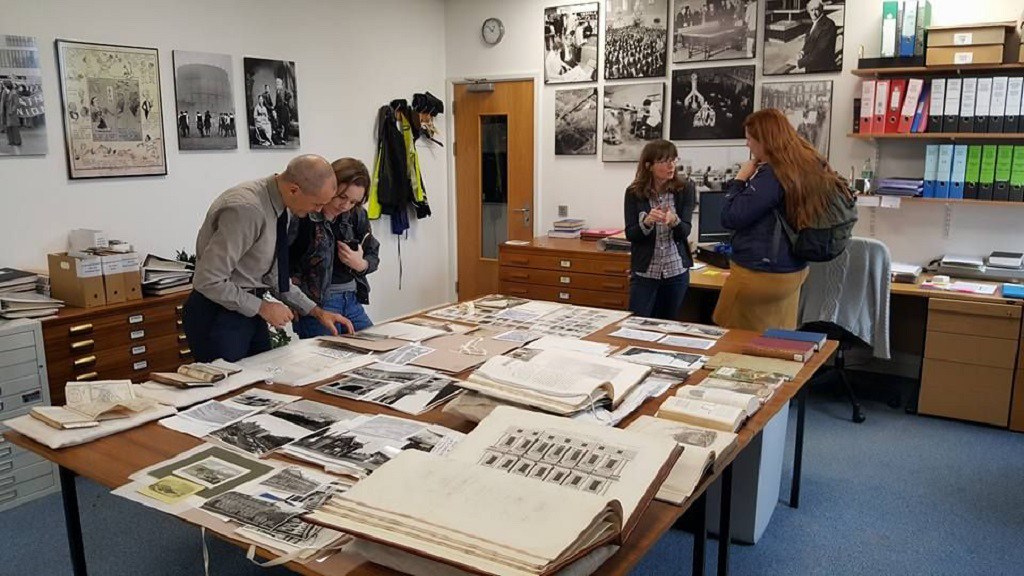9. FUNCTIONAL SPACES

Considerations and Rationale:
Functional spaces are the areas and spaces to which records are moved for the use of researchers, staff, and the public. The movement of a record into and through the facility involves many different functional spaces (SAA, 2009, p.133), including: the loading docs, processing rooms; and rooms such as lunchrooms and restrooms to support the work of visitors and staff ( SAA, 2009, p.133). The SAA, therefore, reasoned that functional spaces should be added as a guideline. This is primarily due to the fact that each room may have different climate conditions and other possible substances that can affect the condition of the records.
Greater emphasis in this section is placed on record storage and public places because these are areas where collections are more vulnerable to theft, damage, or other hazards (SAA, 2009, p.133). Less attention is focused on spaces where records reside outside of secure storage but are not exposed to public access ( SAA, 2009, p.133).
GUIDELINES:
The guidelines for Functional Spaces are as follows:
I. LOADING DOCKS:
- Loading docks are the area at the side of a building where goods are loaded onto and unloaded from vehicles (Merriam-Webster, n.d.). In Archival facilities, loading docks function to provide a secure environment for receiving archival collections into the building and to act as a barrier against whether conditions (SAA, 2009, p.134). Archival records that are moving through the loading dock must be protected from theft or unauthorized access, inclement weather, pests, and accidental disposal SAA, 2009, 134). Creating an adequately sized loading dock that will be able to receive a large transfer of records (SAA, 2009, p.135) or placing an appropriately sized cover or canopy over the loading dock platform (SAA, 2009, p. 134) will assist in this protection.
- Location of Loading Dock: The location of the loading dock should be located near stacks; located on the same level as the stacks/or close to freight or large elevators that service archival stacks; adjacent to any inspection and isolation spaces; and located so that noise does not migrate into public and staff working place (SAA, 2009, p. 135). In addition, all loading dock doors should have appropriate security and be installed with weather stripping, and brush sweeps to keep out insects, vermin and mold (SAA, 2009, 136).
- Washable floors and walls (SAA, 2009, p.136)
- Floor drain (SAA, 2009, p.136)
- Fire and smoke protection similar to stack areas (SAA, 2009, p.136)
- Separate air handling system for archival areas (SAA, 2009, p.136)
- Insulation to prevent migration of pests and mold (SAA, 2009, p.136)
- Doors with weather stripping (SAA, 2009, p.137)
- Large enough to house shelving, movable tables, clearly marked trash cans (to distinguish the trash from record boxes)(SAA, 2009, p.137)
- computer station(SAA, 2009, p.137)
III. ISOLATION ROOMS:
Isolation rooms are rooms designated for isolating contaminated records (SAA, 2009, p. 137). The isolation room should have the same design criteria as receiving room and should contain a biological safety cabinet in which materials with mold can be stored and cleaned (SAA, 2009, p.137).
IV. SUPPLY STORAGE ROOMS:
The supply storage rooms are rooms designed for the sole purpose of storing non archival related records. Storage can take the form of office supplies, processing supplies or laboratory supplies.
The following materials should be stored in these areas:
- Archival supplies such as document cases, folders, and acid-free papers (SAA, 2009, p. 137)
- Office supplies, equipment not yet installed (such as spare computers and printers, etc), extra chairs and tables (SAA, 2009, p. 137)
- Staff party supplies and decorations (SAA, 2009, p. 138)
- Laboratory supplies, including chemicals (SAA, 2009, p. 138)
- Attic stock, such as extra tile, floor covering, Heating, Ventilation, and Air-Conditioning filters, etc (SAA, 2009, p. 138)
- Paint fuel, and lawn care equipment-provide secure storage exterior to the building (SAA, 2009, p. 138).
- Separate air handling systems (SAA, 2009, p.139)
- Floor loads that can accommodate heavy laboratory systems (SAA, 2009, p.139)
- Waterproof and skid-resistant floors (SAA, 2009, p.139)
- Floor drains with catch drains and grilles in case of flooding (SAA, 2009, p.139)
- Chemical storage cabinets (which may need special ventilation) (SAA, 2009, p.139)
- Separate spaces for wet and dry work (SAA, 2009, p.139)
- At least one 6-foot wide door to allow for collections and supply movement into and out of the laboratory (SAA, 2009, p.139).
- Filtered and/or deionized water (SAA, 2009, p.139)
- Under-sink water heater to provide 150 degrees Fahrenheit water (SAA, 2009, p.139)
- Eyewashes (SAA, 2009, p.139)
- 220 volt power for special equipment (SAA, 2009, p.140)
- Adequate storage space for large and bulky conservation materials (SAA, 2009, p.140)
- Shelving for reference books (SAA, 2009, p.140)
- One ore more administrative offices or spaces immediately adjacent to the lab itself so that the staff can keep administrative work separate form laboratory work (SAA, 2009, p.140).
- Leak proof spaces (SAA, 2009, p.140)
Laboratory equipment must include:
- Fume hood and hooded venting system (SAA, 2009, p.141)
- Elephant trunks, which are flexible snorkels for capturing light particles and vapors ( (SAA, 2009, p.141)
- Humidification chamber (SAA, 2009, p.141)
- Drying racks (SAA, 2009, p.141)
- Workbenches (SAA, 2009, p.141)
- Movable tables (SAA, 2009, p.141)
- Book Press (SAA, 2009, p.141)
- Chemical-resistant sinks (SAA, 2009, p.141)
- Carts and a cart storage (SAA, 2009, p.141)
- Wall and mobile units for rolled conservation (SAA, 2009, p.141) supplies
- Photographic documentation equipment (SAA, 2009, p.141)
- Microscope (SAA, 2009, p.141)
- Paper cutter (SAA, 2009, p.141)
- Ultrasonic welder (SAA, 2009, p.141)
- Suction table (SAA, 2009, p.141)
- Guillotine (SAA, 2009, p.141)
- Drill press (SAA, 2009, p.141)
- Leaf caster (SAA, 2009, p.141)
- Board Shears (SAA, 2009, p.141)
VIII. REFORMATTING LABORATORY SPACES:
Spaces that provide for scanning and microfilming archival records (such as a reformatting lab) must include:
- Shelving for short term storage of collections being reformatted (SAA, 2009, p. 142)
- Furniture for preparing documents for reformatting (SAA, 2009, p.142)
- Space for a variety of scanning equipment to accommodate all sizes of documents and format types, including microfilm, slides, prints, negatives, and books (SAA, 2009, p.142);
- Spaces for handling large groups of documents or oversized documents (SAA, 2009, p.142)
- Data connections and electrical outlets of a rating compatible with planned reformatting equipment(SAA, 2009, p.142)
- Dimmable lighting(SAA, 2009, p.142)
IX. PROCESSING ROOM:
The processing room provides a space for staff to work individually or in groups in examining, sorting, arranging, describing and rehousing archival materials (SAA, 2009, p.142). Processing rooms should include:
- Large, movable tables for soring records (SAA, 2009, p.143)
- Shelving to hold records, boxes, and archival supplies (SAA, 2009, p.143)
- Adequate open space for parking book trucks and other cards (SAA, 2009, p.143)
- Space to accommodate the maximum number of staff who may work on one collection at a time (SAA, 2009, p.143)
- Counter or table space for computers and computer connections (optional)(SAA, 2009, p.143)
- Any equipment required for processing special format materials, such as audiovisual materials (optional)(SAA, 2009, p.143)
X. COMPUTER ROOMS:
The computer room consists of file servers, routers and other equipment supporting the computer network (SAA, 2009, p.143) and should include:
- Raised access flooring and anti-static floor covering if conditions permit (SAA, 2009, p.143)
- Power outlets and flexible tails (SAA, 2009, p.143)
- Computer-grade circuits (SAA, 2009, p.143)
- A plan for wireless networks to be incorporated to provide maximum flexibility (SAA, 2009, p.143)
- Temperature no greater than 70 degrees Fahrenheit (SAA, 2009, p.143)
- No windows (SAA, 2009, p.143)
XI. READING ROOMS:
Reading rooms serve as a space for the public to review archival materials and are usually designed so that records are protected at all times.
Reading room spaces should be:
- Accessible from the public entrance and/or lobby of the archival facility (SAA, 2009, p.146).
- Accessible through a single entrance (SAA, 2009, p.146)
- Located close to staff office, and when possible designated to make the transport of records to the room secure and easy for staff (SAA, 2009, p.146)
- Located in a quiet area of the facility and designed with soundproofing (SAA, 2009, p.146)
XII: RESEARCHER REGISTRATION:
On occasion, there will be space needed for researchers to provide registration information, be briefed on the archives’ rules and regulations, and to consult with staff on individual research requirements (SAA, 2009, p.146).
As a result, such spaces should comprise of:
- Adjacent to textual reading room and other reading rooms (SAA, 2009, p.146)
- Adjacent to finding aids or co-located with finding aids(SAA, 2009, p.146)
- Sound insulation to prevent disruption of other researchers(SAA, 2009, p.146)
- Windows into research areas to allow staff to visually monitor reading rooms (SAA, 2009, p.147)
- Data access through cabling or wireless connections (SAA, 2009, p.147)
XIII. TEXTUAL READING ROOMS:
Textual reading rooms provide researchers with an opportunity to consult paper-based archival records (SAA, 2009, p.147). These records range from loose papers in archival boxes to books, to periodicals (SAA, 2009, p.147). To ensure proper handling of records, such rooms should be comprised of:
- Few visual barriers to provide a clear field of view for staff to observe researchers in all parts of the room (SAA, 2009, p.147)
- Automatic door openers for the service doors into the room (SAA, 2009, p.147).
- Staff operated reference desk located centrally within the room so that staff have clear line of sight to to all areas of the room (SAA, 2009, p.147).
- Average work space of 7.5 square feet (SAA, 2009, p.147)
- Researcher tables (SAA, 2009, p.147)
- Research table space for oversized records, such as maps (SAA, 2009, p.147).
- Reading lamps (SAA, 2009, p.148)
- Copiers (SAA, 2009, p.148)
XIV. RECORDS HOLDING ROOM:
A records holding room is a space that temporarily stores records overnight or in advance of the arrival of a researcher (SAA, 2009, p.148).
Records holding rooms should consist of:
- Space to store boxes on shelves, book carts holding boxes of records, and any other equipment used by the repository to transport records to the reading rooms (SAA, 2009, 148).
- Records should not be kept longer than 30 days in the records holding room(SAA, 2009, 148).
- Rooms should adhere to appropriate environmental conditions, fire safety, security, lighting and finishes as the stacks (SAA, 2009, 148)
XV. MICROFILM AND AUDIOVISIUAL READING ROOM:
Microfilm reading rooms should be designed to house and operate the various kinds of equipment needed to access and copy the formats held by the repository (SAA, 2009, p.148). Additionally it should have the capability to lower the lighting levels and provide self service copies of high-use reference film and fiche in cabinets located in or adjacent to the reading room (SAA, 2009, p.148).
Audiovisual reading rooms should have specialized equipment to research audiovisual records including still pictures, videotapes, sound recordings, etc (SAA, 2009, p.149). Audiovisual rooms should not have natural lighting and should have light dimming capabilities (SAA, 2009, p. 149).
XVI. PUBLIC SPACES:
In addition to providing a welcoming space for visitors, archives should be designed to provide an opportunity for communicating the mission and work of the archives to the public (SAA, 2009, p.149). Public spaces should consist of a lobby that has an adequate desk, security, screening area, and seating for visitors (SAA, 2009, p. 149).
- The archives facility should be prepared to host large groups of people. The spaces adjacent to the lobby, therefore, should also consist of a reading room/registration/orientation; public lockers/locker room; public restrooms; meeting or training rooms; auditorium; exhibit gallery(s).
- Pubic service areas can also consist of a food service area with slightly negative air pressure to the rest of the building and away from all archival stacks, exhibits, and other records use areas(SAA, 2009, p.152). If there are gift shops, they should be secured even if other parts of the building are open (SAA, 2009, p. 152).
- Exhibits should be adjacent or near the public lobby(SAA, 2009, p. 153) . If the exhibit displays original materials, it should not be exposed to natural light(SAA, 2009, p. 153). The exhibit preparation space should be large flexible space that includes space for planning, layout work, mat-cutting, exhibit construction, graphics preparation, and storage (SAA, 2009, p.153). Those involved in exhibit preparation must also ensure that the environmental conditions, security, and materials and finishes are appropriate for the prep space (SAA, 2009, p.153).



